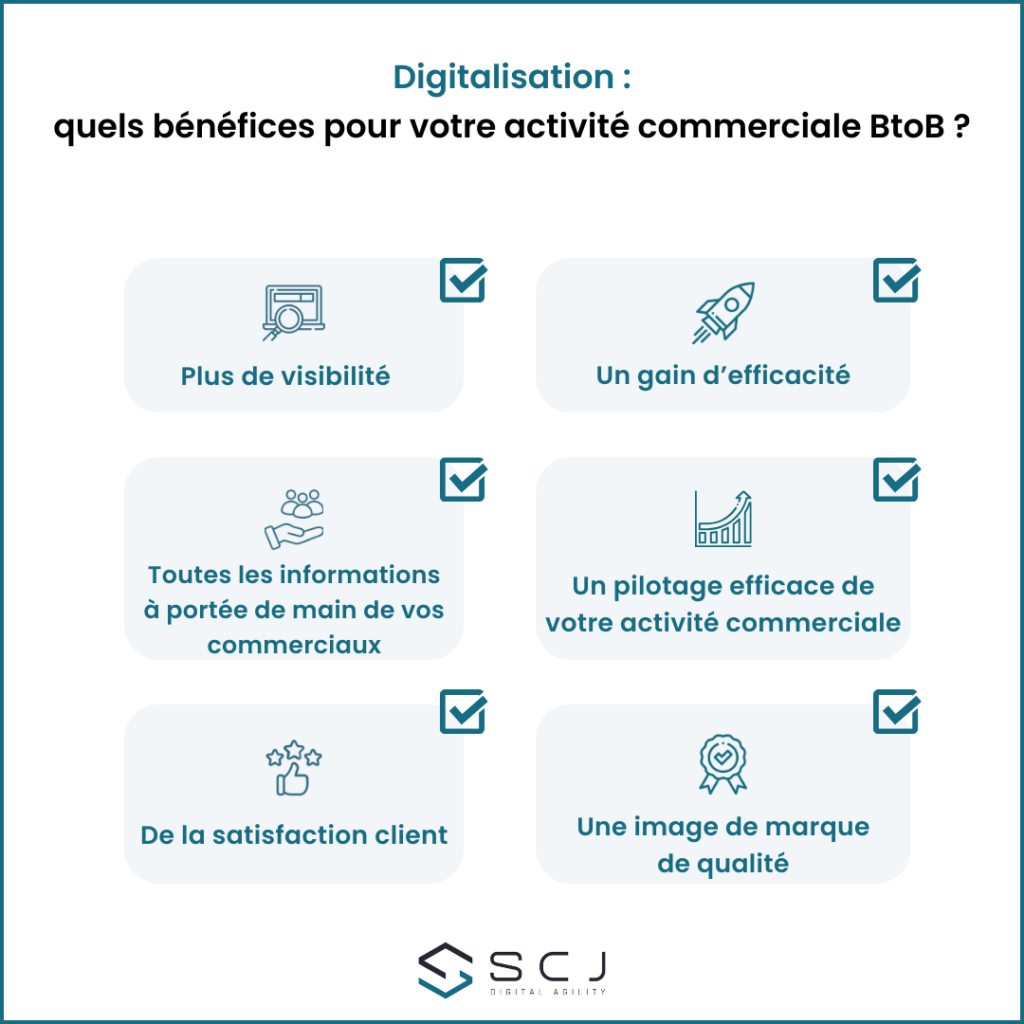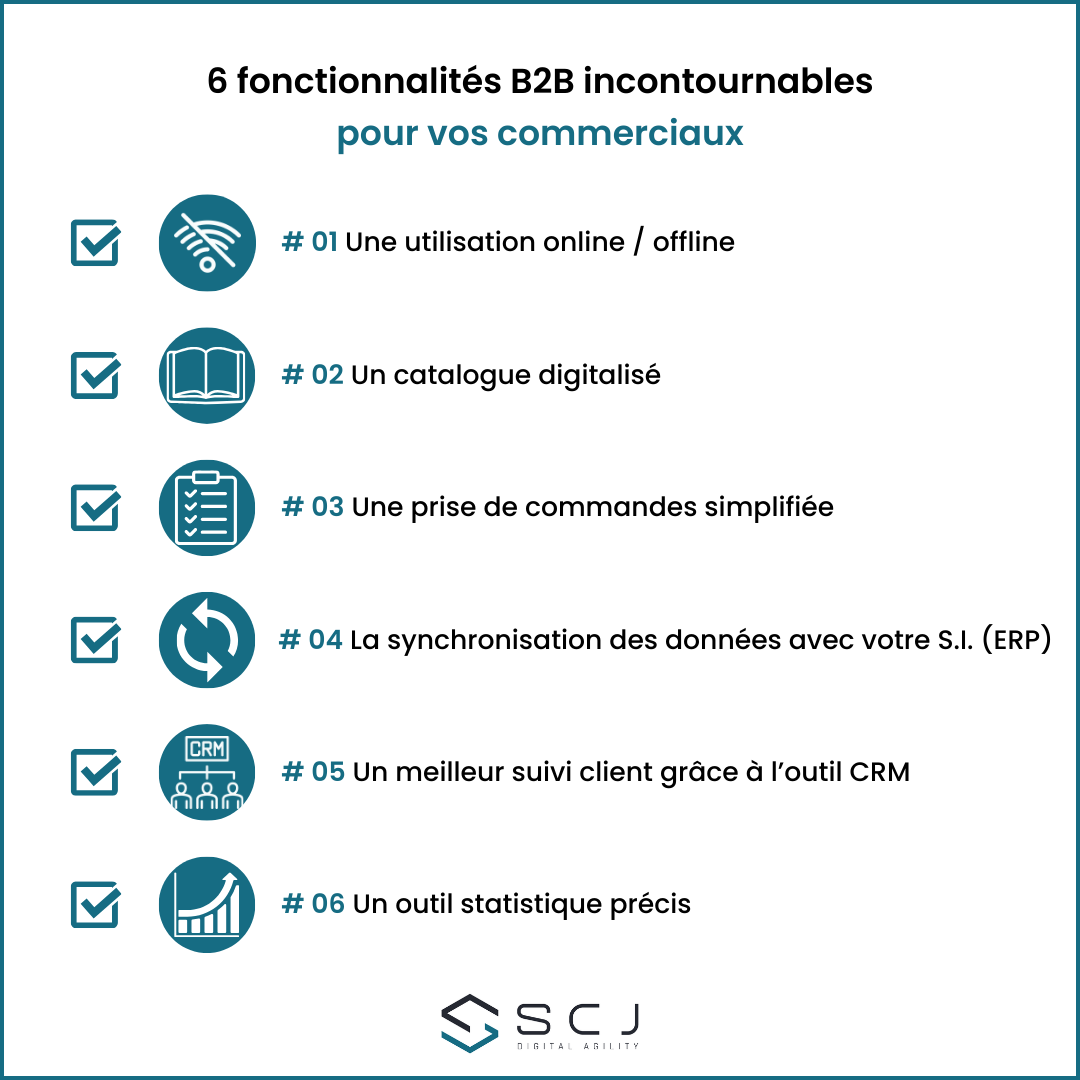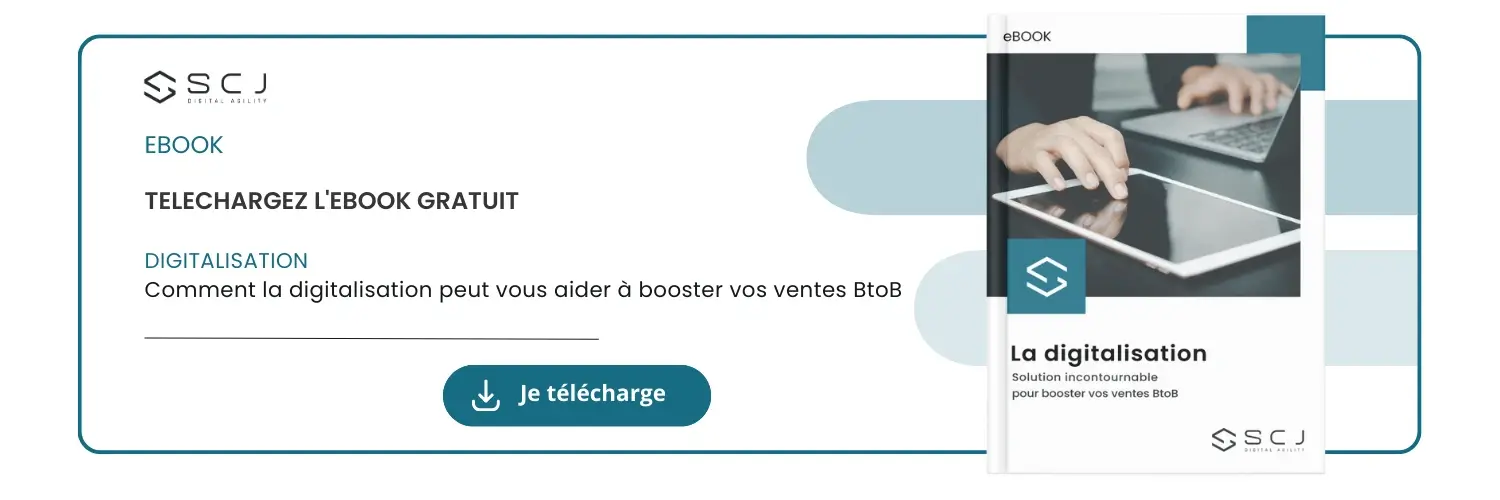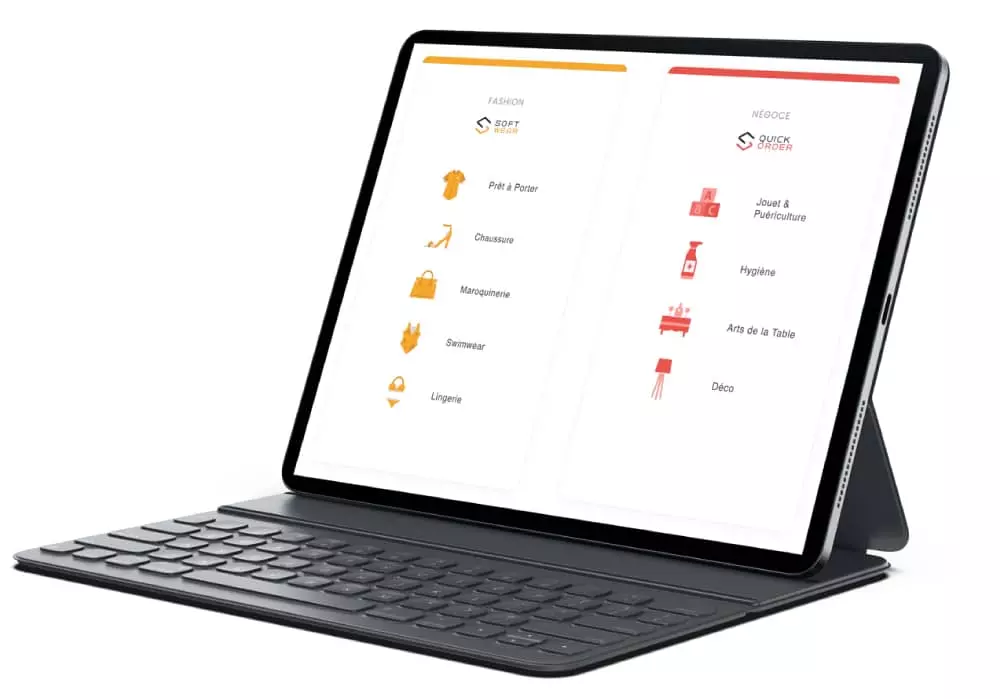In a world that keeps moving faster and faster, B2B companies must constantly seek ways to improve their sales performance while balancing time savings and productivity, in order to remain competitive and ensure long-term success.
Digitalization allows them to optimize the organization of their sales activities, particularly by automating certain recurring tasks.
The goal? Free up more time to focus on consulting and selling, the activities that generate revenue.
But what exactly does B2B sales digitalization involve? How should you organize it? Which solutions should you consider? All the answers are in this article.
Contents:
Why digitalization is a major challenge for B2B sales ?
How to proceed : The 4 steps to follow
Step 1 – The Requirements Specification
Step 2 – Organizing Sales Data
Step 3 – Identifying the right digital tools based on your sales approach
SCJ : The turnkey platform dedicated to digitalizing your B2B sales activities
Why is digitalization a major challenge for B2B sales ?
What is digitalization ?
Digitalization means integrating digital technologies into the various areas of a business (sales, management, communication, customer relations, etc.) to optimize processes and make them more efficient.
Why has B2B sales digitalization become essential today ?
Today, digitalization is a prerequisite to optimize your sales organization and stay competitive. Digital tools are here to save you time. This involves :
- Equipping your sales team with an effective digital tool that increases productivity by automating time-consuming, low-value tasks, giving them more time to focus on selling. Choosing the right hardware is also an important consideration.
- Implementing B2B e-commerce: With the new generation of buyers accustomed to personal online shopping, they increasingly use this channel for professional purchases. This makes it necessary to adapt your sales process by providing your clients an additional online buying channel.
What are the benefits of digitalizing your B2B sales activities ?
Digitalization offers many advantages for your business :

- Greater visibility : Especially online, with a 24/7 e-shop, leading to more sales opportunities.
- Increased efficiency : Automating recurring tasks and ensuring reliable data through synchronization saves significant time, allowing your team to focus on selling. Collaboration and information sharing become more effective.
- All information at your sales team’s fingertips : On their dashboard, salespeople can see all the information they need at a glance: client data (last order dates, typical order quantities, etc.), product information (availability, packaging, etc.).
- Effective business monitoring : Gain precise tracking of your statistics (sales per client, client outstanding balances, visit reports, etc.).
- Maintaining strong customer relationships : Always accessible offerings, real-time information, and precise data analysis to identify sales opportunities contribute to client satisfaction and loyalty.
- Quality brand image : Digitalization projects a modern and dynamic image of your company, building trust in your sales interactions and leaving a positive impression of performance and efficiency.
Where to start ? The 4 steps to digitalizing your B2B sales activities
Step 1 : Create a requirements specification
Writing a requirements specification is a crucial step. This document allows you to define your objectives, clearly identify client issues, and understand the needs related to your sales activities to help you choose the right digital tools. It should include :
- Your company objectives and related needs
- Expected features to meet your needs
- Technical constraints
- Allocated budget
- Stakeholders and their roles
- An action plan with a timeline for each step
SCJ offers a free audit to assess your current level of digitalization, your sales activity needs, and the digital solutions available to boost your B2B sales.

Step 2 : Organize your sales data
Reliable data requires proper organization from the start (clients, products, stock, pricing, etc.) and centralization in one tool :
– Using Excel, if you are just starting your business
– Using ERP software if you have large volumes of data to manage
A common mistake is digitizing processes without first carefully organizing your data. Proper planning is essential.
Excel database :
If you are starting out, Excel helps you quickly build your first databases. Simple, flexible, and cost-effective, it’s ideal for creating a basic client or product database for managing simple collections.

However, the more your business grows, the more Excel will quickly show its limitations when dealing with large volumes of data.
ERP system :
An ERP (Enterprise Resource Planning) system centralizes all tools and data for managing your business:
- Sales management (Quotes, Invoices, CRM, etc.)
- Accounting and finance
- Supply chain management (purchasing, inventory, logistics, transport)
- Customer service (tickets, complaints, etc.)
ERPs ensure data uniqueness, automatic updates, and real-time information sharing across departments.
Choosing an ERP is a significant investment, so analyzing your internal organization and identifying needs upfront is crucial.
Step 3 : Identify the right digital tools for your sales model
Ask yourself : What is your market? Who are your clients? What are their expectations? These factors help you select a sales model aligned with your needs: field sales, B2B e-commerce, or a hybrid.

All these criteria will enable you to choose a marketing method that suits your needs, either physically by setting up a sales force, virtually by creating a B2B e-commerce site, or by combining the two.
✔️ If you have a field sales team
Whether internal (employees) or external (agents), you can digitalize your sales team using the right tools.
• With an SFA tool
Sales Force Automation (SFA) software helps your sales team automate part of their work, making order entry, communication tracking, and data analysis easier, improving both client relationships and sales management.
To help you make your choice, here are some essential features that your SFA application must have in order to support your sales force on a daily basis.
Focus on 6 essential B2B features for your sales force

⇨ Online/offline access :
Don’t fall into the trap ! Make sure that the application you choose can work just as well offline as it does online.
Indeed, there is nothing worse for your sales representatives than not being able to confirm an order during an appointment due to a lack of network coverage!
Your field sales representatives need a digital tool that can work in all circumstances, both online and offline, without being dependent on a good internet connection.
By choosing an SFA application with online/offline functionality, your sales representatives can place orders even when they don’t have network access during customer appointments. They can connect at another time to send pending orders to headquarters.
⇨ Digital catalog
One of the essential features of an SFA application is a digital catalog of all your products. All your product information is centralized, customized listings and commercial terms are displayed for each customer, and inventory is updated.
Searching for information is made much easier thanks to the intuitive search bar, search filters, etc. This saves valuable time for your sales force, who can say goodbye to heavy paper catalogs and easily access all your product data on their tablets, which are much lighter and more convenient to use!
With photos, presentation videos, and product demonstrations, the digital catalog gives you access to a wide range of sales materials to share with your customers, featuring high-quality visuals that showcase your products. The goal is to attract your customers and help them visualize your products for their orders to set up or restock their points of sale.
The catalog helps your sales representatives achieve their sales targets by suggesting items from the same product family or complementary items to help your customers fill their shopping carts. Is one of your products temporarily out of stock? The catalog can suggest substitute items to satisfy your buyers and seize every sales opportunity!
⇨ Simplified order entry
A good SFA application should enable your sales representatives to enter purchase orders extremely quickly, particularly based on order histories, so that they don’t waste time re-entering recurring orders.
Order duplication is also a useful feature when your distributor customer requests the same order for several of their points of sale, for example.
Created from the digital catalog and linked to the customer file, the purchase order is generated in a matter of minutes. As it is paperless, your customer can validate it with an electronic signature.
Ensure that your future SFA tool is equipped with these features to save valuable time!
⇨ Data synchronization with ERP
Orders are sent directly to the central system and data is automatically synchronized: no more loss of information, duplicates, or data entry errors. Information is unified, centralized, and reliable.
When choosing your tool, be sure to check that it is compatible with your ERP system.
⇨ Better customer follow-up thanks to the CRM tool
Most SFA tools come with CRM (Customer Relationship Management) software, which focuses on tracking and managing customer relationships. With CRM, your sales reps have their contact files at their fingertips and can view, add, and update information about their customers and prospects. With better visibility of this data, they can identify high-potential customers or, conversely, detect unusual dips in activity and respond quickly by taking corrective action if necessary.
Customers to follow up with, quotes in progress, outstanding customer accounts… all important information that your SFA tool must highlight to help your sales representatives in their daily activities.
⇨ A precise statistical tool
A high-performance SFA application must also have a precise statistical analysis tool for your figures, generated from visit reports, reports, and sales data. This will enable you to monitor your sales force’s commercial activity and determine the actions to be taken to increase your turnover.
• With the right equipment
Digitizing your sales force also involves choosing suitable, high-performance hardware that is robust enough to keep up with the hectic pace of their days as they travel extensively.

In this article, discover the six criteria to consider to help you make your choice: What equipment should you choose for your field sales representatives?
✔️ If your strategy relies on a B2B e-commerce website
E-commerce is becoming a real growth driver for the B2B sector and continues to grow: in France, sales to professionals are growing at an average rate of around 15% per year (Fevad).
Based on this observation, you are considering setting up a B2B e-commerce website to market your products.
While combining aesthetics and ergonomics, your e-commerce site must take into account the specific characteristics of the B2B sector in order to offer services tailored to your professional customers and consistent with the needs of your business.
A few essential features for your B2B e-commerce website

⇨ A digital catalog personalized according to each client’s profile
Unlike the B2C market, where the offer is often unique (one brand associated with a single online store and a single pricing system), the B2B sector has a more complex commercial management. Some distributor clients have specific commercial terms and only reference part of the products depending on their structure, targeting, location, etc.
A B2B site must therefore provide product references, commercial conditions, and pricing specific to each client according to their type (purchasing center, supermarket, store, etc.). The composition of the digital catalog is therefore evolving, and its display must adapt according to the profile of the buyer connecting to the site.
Given the volume of products offered in B2B (sometimes up to several thousand different SKUs), special attention must be given to the organization of product ranges (families, sub-families). This requires upfront reflection on the site’s structure to ensure navigation remains logical and intuitive. The goal is to provide a clear presentation so that your offer remains readable and relevant.
⇨ Accurate pricing management
In addition to client-specific pricing based on negotiated commercial conditions, B2B pricing management must also take into account sometimes complex discount systems: discounts according to the type of products ordered (percentage per item / per family), according to quantities (percentage or tiered discounts depending on volumes ordered, packaging chosen, in lots), according to order amounts (decreasing prices)… These are all combinations that your B2B e-commerce site must be able to handle.
⇨ Order placement
In B2B, many purchases are recurring: to save time, professional buyers must be able to easily place a new order directly from their purchase history.
Your website should also include an intuitive search bar (by product name, product code, etc.) and product filters to sort and facilitate your clients’ searches (by size, color, type of product, price, etc.).
The shopping cart must remain accessible and visible to encourage conversions with a minimal number of clicks (cart summary, saving, adding/removing items…).
⇨ Specific payment and billing methods
Depending on order volumes, professional buyers may have specific needs regarding payment methods (due date payment, deferred payment, discounts, credit lines…), a configuration that your site must support.
⇨ Multi-store management
In B2B, your site must be able to manage multiple stores from a single back office, allowing centralized order management from a single product catalog (for a specific market, range, brand, country, currency…).
⇨ Inventory management
The inventory management feature is important to inform clients of product availability, stockouts, tracking of backorders (items already ordered but not yet delivered), order cancellations, etc.
⇨ Sales promotion
To remain attractive, your B2B e-commerce requires dynamic and varied displays. Pop-ups, sliders, carousels—these are tools at your disposal to highlight certain products or events, encourage purchases, and boost sales!
⇨ User management
Unlike B2C, B2B e-commerce must manage different user profiles throughout the purchasing process: the client placing the order is not necessarily the one approving it or making the payment.
The importance of good UX/UI design in B2B
Your buyers adopt the same behaviors for professional purchases as for personal ones and now expect a B2B e-commerce site to provide the same ease of use as in B2C.

UX/UI Design is based on User Experience, i.e., the client’s perception while navigating your e-commerce site. The goal is to streamline their purchasing journey, making it as simple and pleasant as possible.
A good UX/UI design, in summary, means:
- A simple and clear site with good ergonomics (simple structure, accessible navigation menus, …)
- An attractive design
- A responsive website, with a display adapting to any device (PC, tablet, smartphone…)
- A Mobile First approach can also be interesting, by developing a mobile app in parallel with your site, providing an ergonomics better suited to smartphones. Indeed, many professional buyers place orders outside their office.
Step 4 : Support the change
Through good internal communication
Consulting your employees provides key information such as daily challenges, digitalization needs, and how user or client experience can be improved.
This will help clarify which actions to prioritize and explain the necessity of your digital transformation by presenting the benefits it brings.
The importance of training and quality support
Training is an essential step to provide future users with a proper understanding of the chosen solution and convince them of the usefulness of digitalization.
When choosing your provider, check if they are Qualiopi certified. This certification guarantees the quality of the training and support provided and also allows eligibility for public funding organizations such as OPCOs, for example.
Also check if the provider offers a quality, available, and responsive support service, prioritizing human contact in interactions.
This support will help effectively combat resistance to change and create buy-in around the new digital tool, ensuring it is easily adopted by everyone.

SCJ, the turnkey platform dedicated to B2B sales digitalization
SCJ supports and covers your entire sales activity from order taking to B2B sales management with an all-in-one, simple, and intuitive platform, which includes :
- An online/offline mobile app for your field sales team
- A 24/7 B2B e-commerce showroom for new product and restock orders
- Centralized data management, 100% compatible with all ERPs on the market
SCJ is a team dedicated to your digitalization projects, with:
100% Made in France







